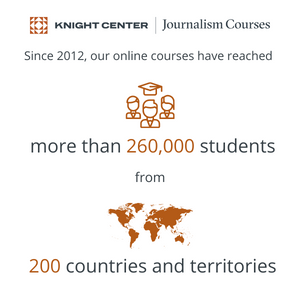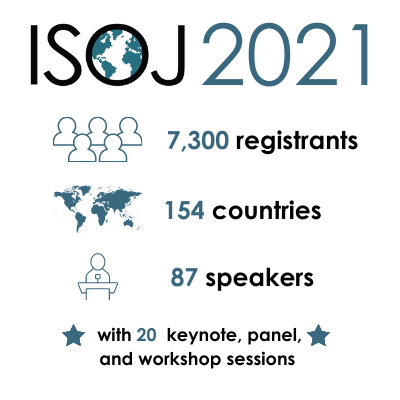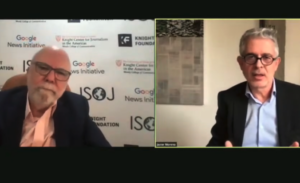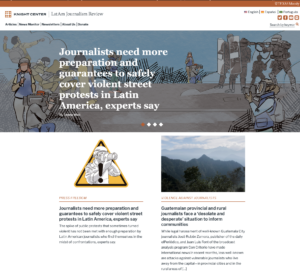
In 2021, the Knight Center reached more journalists than ever before through its distance learning program, its International Symposium on Online Journalism (ISOJ), its trilingual news magazine, webinars, and several other programs.
We were quick to respond to journalists’ needs in 2021, particularly when it came to training journalists on how to better understand and cover the ever-evolving pandemic, and combat misinformation and disinformation surrounding COVID-19 and the vaccinations. We also held ISOJ fully online for the second year in a row and reached our biggest audience yet. Additionally, we held the first-ever conference on diversity in Latin America, and launched a related ebook.
As the year comes to an end, we’re reflecting on these activities and more, and looking ahead to how we will continue training and supporting journalists from around the world in 2022.
Here are some highlights from our work in 2021:
 In 2021, we reached an important milestone: Our massive online courses have now reached more than a quarter of a million students from 200 countries and territories since 2012. In celebration of this milestone, we collected testimonials from students from around the world who say that the Knight Center’s courses have had a profound impact on their professional development.
In 2021, we reached an important milestone: Our massive online courses have now reached more than a quarter of a million students from 200 countries and territories since 2012. In celebration of this milestone, we collected testimonials from students from around the world who say that the Knight Center’s courses have had a profound impact on their professional development.
Over the past year alone, the Knight Center offered 18 online courses that reached more than 29,500 students from 178 countries. The courses were taught by leading journalists who shared their expertise on topics such as digital audio storytelling, data journalism, digital investigations, newsletter strategies, diversity in news & in newsrooms, disinformation & fact-checking, product thinking & more. We worked with several organizations that helped make these courses possible, including the John S. and James L. Knight Foundation, Google News Initiative, UNESCO, the United Nations Development Programme, Microsoft, the Serrapilheira Institute, and the International Women’s Media Foundation.
In some cases, our courses were tied to related events and the publication of ebooks. Similar to 2020, we responded swiftly to journalists’ needs during the pandemic by offering a webinar and MOOC by the same name: “Covering the COVID-19 vaccines: What journalists need to know.” Both were held in partnership with UNESCO, the World Health Organization and the United Nations Development Programme, and co-funded by the European Union.
The webinar attracted more than 2,500 registrants from around the world and featured journalists, virologists, and medical experts who talked about best practices for covering the vaccines, with a focus on the science behind the vaccines and the distribution of them. The webinar was held live in five languages, and recordings of the webinar are now available in 13 languages: Arabic, Bambara, Chinese, Dari, English, French, Guarani, Hindi, Pashto, Portuguese, Russian, Spanish, and Wolof.
Following the webinar, we held a related MOOC in English, Spanish, Portuguese & French that attracted 4,410 students from 160 countries. The course — which was taught by U.S. science and health journalist Maryn McKenna — featured videos from the heads of the World Health Organization, UNESCOand the United Nations Development Programme, as well as guest speaker interviews with medical experts and leading journalists covering COVID-19. Self-directed versions of these four courses are now available in six languages: English, Spanish, Portuguese, French, Russian, and Guarani, with more on the way.
This past year we also held a Spanish-language MOOC on diversity in the news and in newsrooms, sponsored by Google News Initiative. The MOOC, taught by Peruvian journalist and scholar Marco Avilés, attracted 1,920 students from 50 countries. The course provided strategies on how to diversify newsrooms and offered up tools for recognizing racial biases and stereotypes in coverage.
 Following the MOOC, we held the first-ever Latin American conference on diversity, equity, and inclusion (DEI) in journalism. The event, also sponsored by Google News Initiative, featured 19 speakers who addressed four main topics: gender, sexual orientation, race/ethnicity, and disabilities. The speakers offered up best practices and practical tips that complemented the lessons relayed in the MOOC. Each session was streamed live to YouTube, and the recordings are now available on the Knight Center’s YouTube page for anyone who wishes to view them. Soon after the event, we published a related Spanish-language ebook, “Diversity in Latin American Journalism” which was announced during the annual conference of the National Association of Hispanic Journalists (NAHJ).
Following the MOOC, we held the first-ever Latin American conference on diversity, equity, and inclusion (DEI) in journalism. The event, also sponsored by Google News Initiative, featured 19 speakers who addressed four main topics: gender, sexual orientation, race/ethnicity, and disabilities. The speakers offered up best practices and practical tips that complemented the lessons relayed in the MOOC. Each session was streamed live to YouTube, and the recordings are now available on the Knight Center’s YouTube page for anyone who wishes to view them. Soon after the event, we published a related Spanish-language ebook, “Diversity in Latin American Journalism” which was announced during the annual conference of the National Association of Hispanic Journalists (NAHJ).
Among our other 2021 courses was a Portuguese-language science journalism MOOC taught by science journalist Thiago Medaglia. The course, sponsored by the Serraphileira Institute, attracted 2,378 students from 36 countries and offered up practical tips and insights on how journalists can improve their coverage of the pandemic, climate crisis and more. In tandem with this MOOC project, and in coordination with Serrapilheira, the Knight Center also published the Portuguese translation of the Knight Science Journalism’s Science Editing Handbook (Manual de Edição em Jornalismo Científico). The handbook, which is a product of the Knight Science Journalism (KSJ) Fellowship at the Massachusetts Institute of Technology, features chapters written by renowned science editors and journalists, and provides resources for editing and reporting science journalism. It’s now available in the Knight Center’s digital library on JournalismCourses.org.
We have several new courses lined up for 2022, including ones on live journalism, entrepreneurial journalism, photogrammetry, and more. We are also planning another webinar aimed at helping journalists cover the latest COVID-19 developments, scheduled for January 27, 2022. We encourage you to visit JournalismCourses.org in the coming weeks for more details. We also invite you to check out our 45 self-directed courses, which you can access for free at any time.
 For the second time in our 22-year history, we held ISOJ fully online due to the pandemic. ISOJ 2021 was a five-day virtual conference that turned out to be our biggest ISOJ yet, attracting 7,300 registrants from 154 countries. ISOJ was also streamed live on our YouTube channel, and the YouTube recordings had been viewed more than 8,500 times in Englishand in Spanish.
For the second time in our 22-year history, we held ISOJ fully online due to the pandemic. ISOJ 2021 was a five-day virtual conference that turned out to be our biggest ISOJ yet, attracting 7,300 registrants from 154 countries. ISOJ was also streamed live on our YouTube channel, and the YouTube recordings had been viewed more than 8,500 times in Englishand in Spanish.
ISOJ 2021 featured 20 different keynotes, panels, and workshops with 87 speakers from 13 countries. Here’s a snapshot of some of the speakers who joined us:
During ISOJ Online, we released the 11th volume of the #ISOJ Journal, the official publication that is part of the conference’s research component. Unlike traditional academic journals that often take a year or two to publish peer-reviewed articles, the #ISOJ Journal is available every year at the annual conference. This year's journal, available here online, took a special look at the evolution of online journalism today: from algorithms to zombie news sites. The six articles included in this issue were selected from the blind-reviewed 2021 ISOJ paper competition and were presented at ISOJ.
We hope you’ll save the date for ISOJ 2022, which will be held from April 1-2, 2022. We are planning to hold it both in-person and online, (provided it’s safe enough to do so), and will open registration in January on isoj.org.

Rosental Alves and Javier Moreno speak at the 14th annual Ibero-American Colloquium on Digital Journalism
We transformed our 14th annual Ibero-American Colloquium on Digital Journalism into an online event for the second year in a row. This year's Colloquium attracted our biggest audience yet: 1,427 registrants from 47 countries. The event, which was sponsored by Google News Initiative, featured 33 speakers and seven compelling sessions of interest to Ibero-American journalists.
The event kicked off with a keynote talk from Javier Moreno, editor-in-chief of El Pais. For the first time ever, we held the Colloquium not just in Spanish but in Portuguese as well, making it more accessible than ever before. The event was also streamed in Spanish and in Portuguese on YouTube. The streams have been viewed more than 3,000 times.
In 2021, the Knight Center also held other programming specifically focused on Latin America, including the aforementioned DEI event and a webinar titled “Journalism in Times of Polarization and Disinformation in Latin America.” The webinar, which was held in English, Spanish, and Portuguese in partnership with the LLILAS Benson Latin American Studies and Collections, attracted 1,185 registrants from over 30 countries. The event featured 15 speakers who discussed challenges for journalists who become targets in polarized societies; how journalists in Latin America have reacted to waves of disinformation; and the press' role in defending democracy and freedom of expression.
 In 2021, the Knight Center continued to grow its trilingual news magazine, LatAm Journalism Review, which launched in 2020 and grew out of Knight Center’s 17-year-old Journalism in the Americas blog. LJR is a unique publication of record regarding journalism in Latin America and the Caribbean, and it features in-depth, original reporting on press freedom and journalism innovations in Latin America and the Caribbean. The site also features a News Monitor — a compilation of headlines of the most important news related to journalism and press freedom published by news organizations in Latin America and the Caribbean.
In 2021, the Knight Center continued to grow its trilingual news magazine, LatAm Journalism Review, which launched in 2020 and grew out of Knight Center’s 17-year-old Journalism in the Americas blog. LJR is a unique publication of record regarding journalism in Latin America and the Caribbean, and it features in-depth, original reporting on press freedom and journalism innovations in Latin America and the Caribbean. The site also features a News Monitor — a compilation of headlines of the most important news related to journalism and press freedom published by news organizations in Latin America and the Caribbean.
Over the past year, LJR has published 240 original stories (for a total of 720 articles in English, Spanish, and Portuguese), and just this month the site launched a new series on journalists’ safety in Latin America and the Caribbean, with support from UNESCO’s Global Media Defence Fund.
Here’s a look at the most interesting and important stories that the LJR team reported and published in 2021:
We hope you’ll visit latamjournalismreview.org for more stories in 2022 and that you’ll subscribe to our weekly trilingual newsletter.
****
The Knight Center’s mission to serve journalists has never been more important, amid the COVID-19 pandemic, growing threats against press freedom, and the need for accessible, free training.
Our work wouldn’t be possible without generous support from our funders, partners, and individuals like you. We hope you’ll consider supporting us so that we can continue offering free and low-cost training and events to journalists from around the world in 2022. If you’re interested in making a donation to the Knight Center, (which is tax-deductible for U.S. residents), you can do so here.
We’re grateful for the Knight Center community and we look forward to serving you in the new year!